An organized body of knowledge
VerifiedAdded on 2022/09/16
|8
|1299
|22
AI Summary
Contribute Materials
Your contribution can guide someone’s learning journey. Share your
documents today.
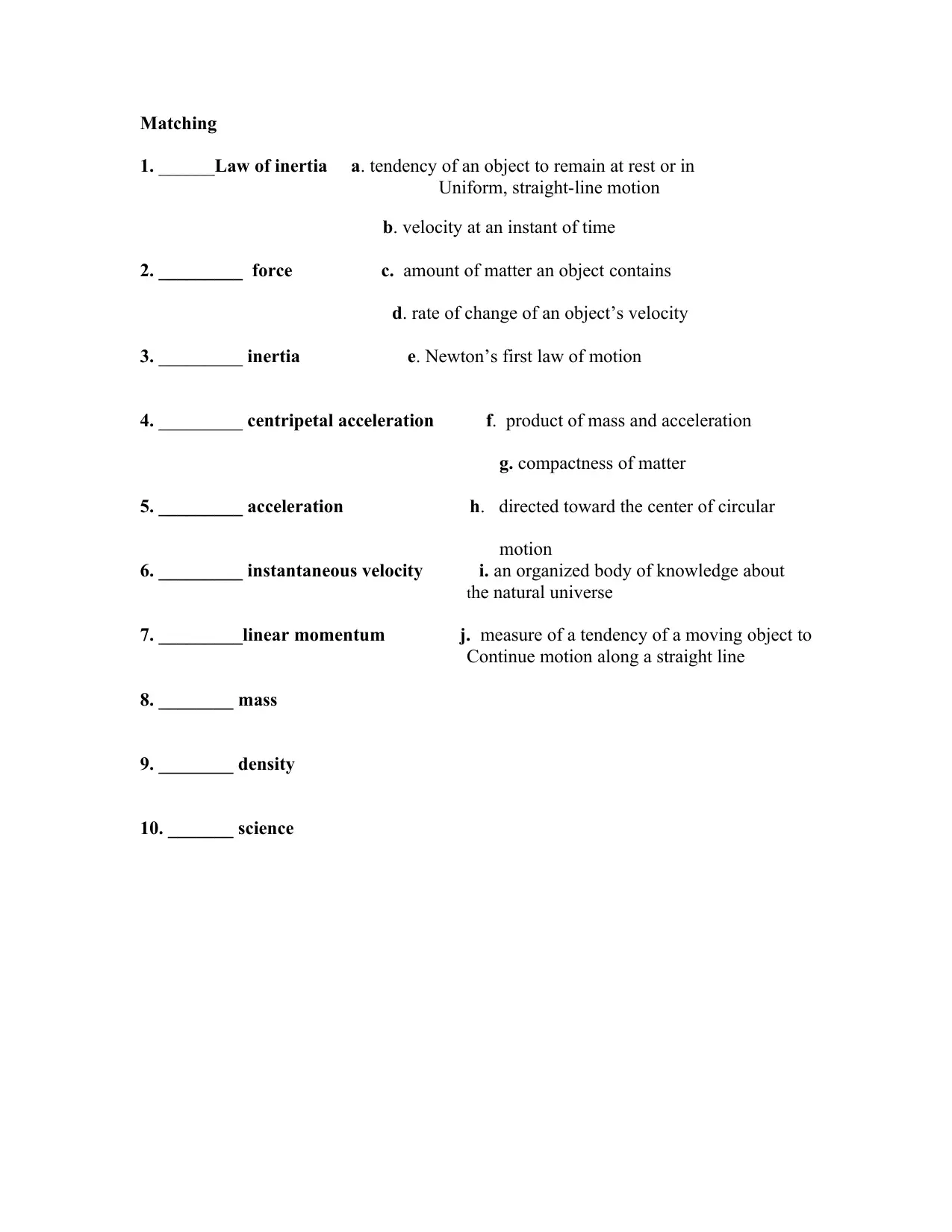
Matching
1. ______Law of inertia a. tendency of an object to remain at rest or in
Uniform, straight-line motion
b. velocity at an instant of time
2. _________ force c. amount of matter an object contains
d. rate of change of an object’s velocity
3. _________ inertia e. Newton’s first law of motion
4. _________ centripetal acceleration f. product of mass and acceleration
g. compactness of matter
5. _________ acceleration h. directed toward the center of circular
motion
6. _________ instantaneous velocity i. an organized body of knowledge about
the natural universe
7. _________linear momentum j. measure of a tendency of a moving object to
Continue motion along a straight line
8. ________ mass
9. ________ density
10. _______ science
1. ______Law of inertia a. tendency of an object to remain at rest or in
Uniform, straight-line motion
b. velocity at an instant of time
2. _________ force c. amount of matter an object contains
d. rate of change of an object’s velocity
3. _________ inertia e. Newton’s first law of motion
4. _________ centripetal acceleration f. product of mass and acceleration
g. compactness of matter
5. _________ acceleration h. directed toward the center of circular
motion
6. _________ instantaneous velocity i. an organized body of knowledge about
the natural universe
7. _________linear momentum j. measure of a tendency of a moving object to
Continue motion along a straight line
8. ________ mass
9. ________ density
10. _______ science
Secure Best Marks with AI Grader
Need help grading? Try our AI Grader for instant feedback on your assignments.
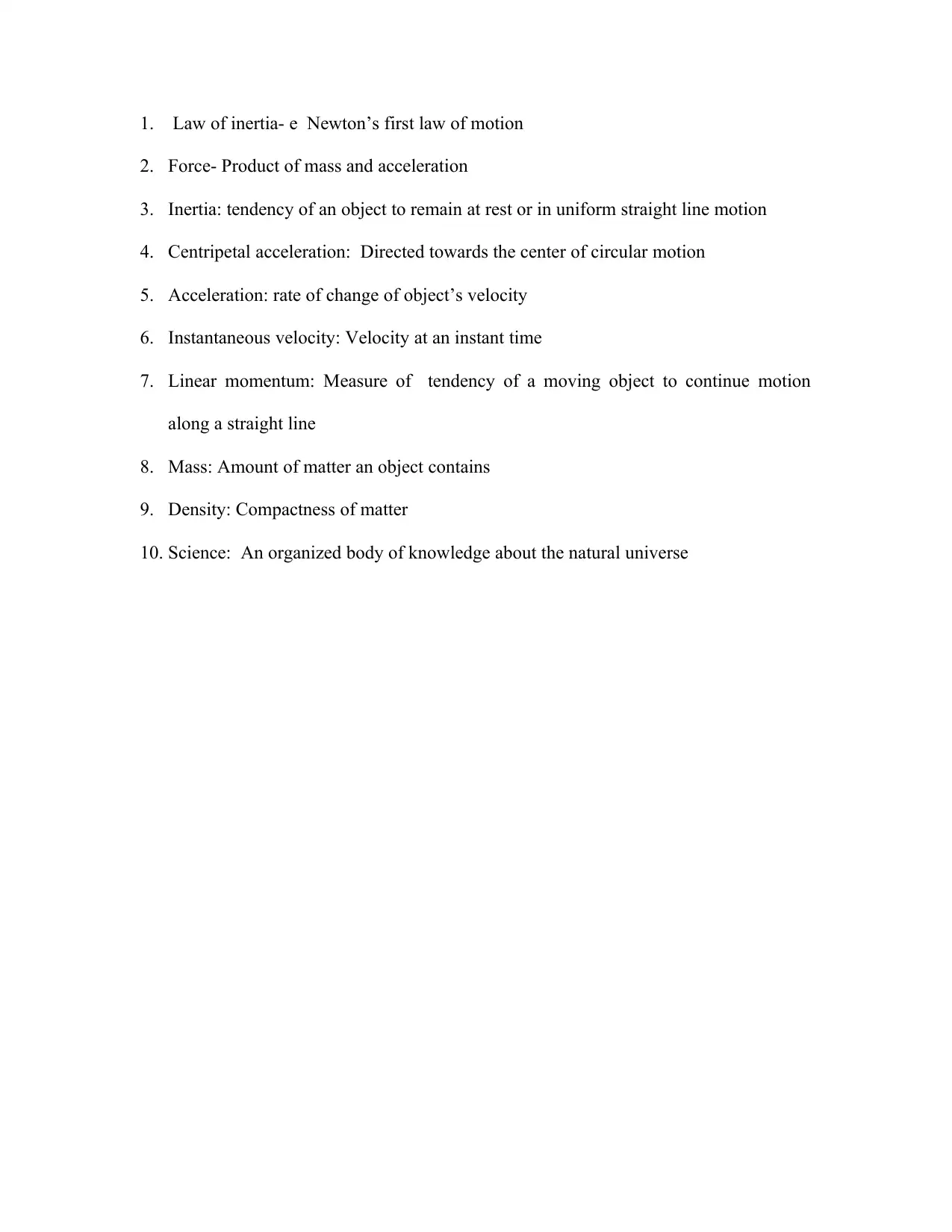
1. Law of inertia- e Newton’s first law of motion
2. Force- Product of mass and acceleration
3. Inertia: tendency of an object to remain at rest or in uniform straight line motion
4. Centripetal acceleration: Directed towards the center of circular motion
5. Acceleration: rate of change of object’s velocity
6. Instantaneous velocity: Velocity at an instant time
7. Linear momentum: Measure of tendency of a moving object to continue motion
along a straight line
8. Mass: Amount of matter an object contains
9. Density: Compactness of matter
10. Science: An organized body of knowledge about the natural universe
2. Force- Product of mass and acceleration
3. Inertia: tendency of an object to remain at rest or in uniform straight line motion
4. Centripetal acceleration: Directed towards the center of circular motion
5. Acceleration: rate of change of object’s velocity
6. Instantaneous velocity: Velocity at an instant time
7. Linear momentum: Measure of tendency of a moving object to continue motion
along a straight line
8. Mass: Amount of matter an object contains
9. Density: Compactness of matter
10. Science: An organized body of knowledge about the natural universe
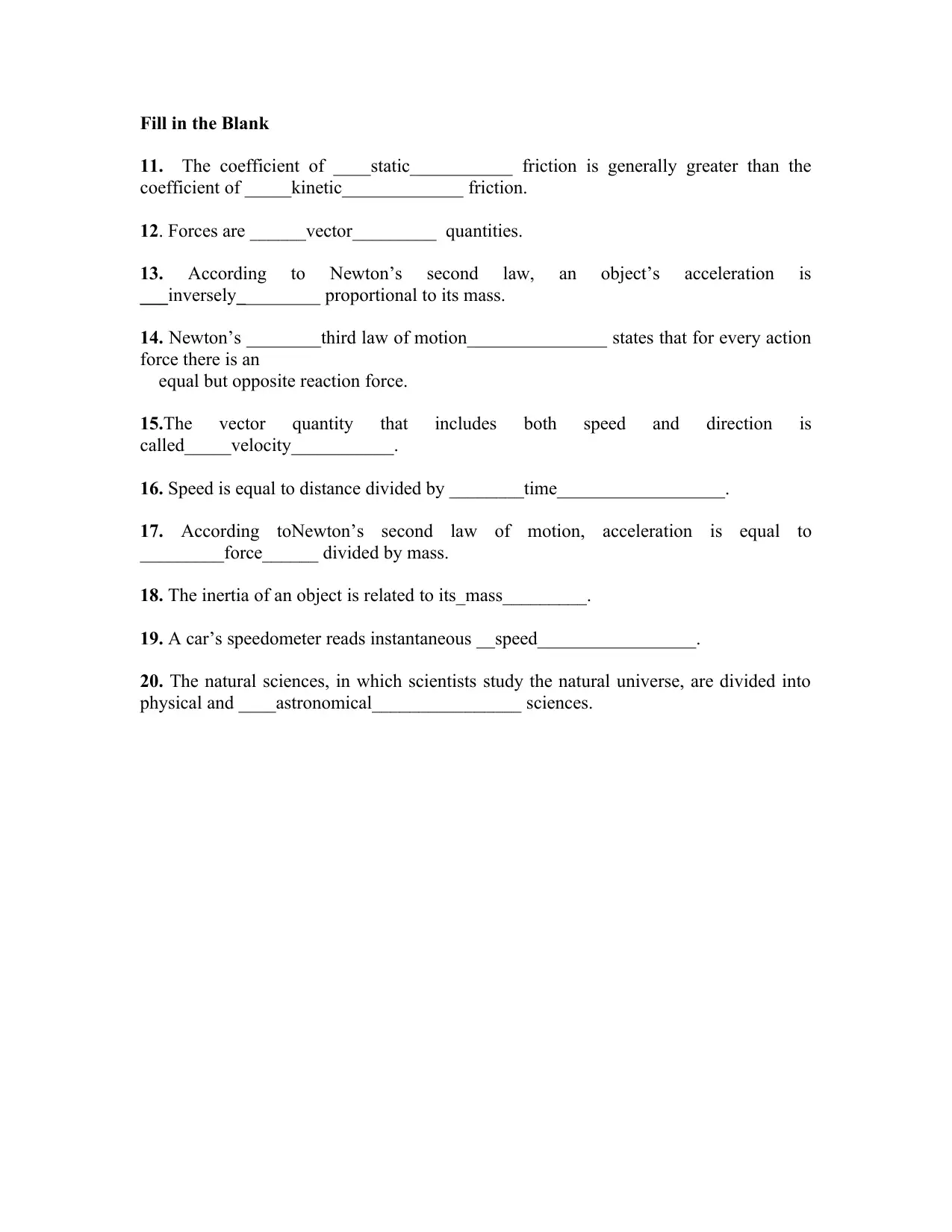
Fill in the Blank
11. The coefficient of ____static___________ friction is generally greater than the
coefficient of _____kinetic_____________ friction.
12. Forces are ______vector_________ quantities.
13. According to Newton’s second law, an object’s acceleration is
___inversely_________ proportional to its mass.
14. Newton’s ________third law of motion_______________ states that for every action
force there is an
equal but opposite reaction force.
15.The vector quantity that includes both speed and direction is
called_____velocity___________.
16. Speed is equal to distance divided by ________time__________________.
17. According toNewton’s second law of motion, acceleration is equal to
_________force______ divided by mass.
18. The inertia of an object is related to its_mass_________.
19. A car’s speedometer reads instantaneous __speed_________________.
20. The natural sciences, in which scientists study the natural universe, are divided into
physical and ____astronomical________________ sciences.
11. The coefficient of ____static___________ friction is generally greater than the
coefficient of _____kinetic_____________ friction.
12. Forces are ______vector_________ quantities.
13. According to Newton’s second law, an object’s acceleration is
___inversely_________ proportional to its mass.
14. Newton’s ________third law of motion_______________ states that for every action
force there is an
equal but opposite reaction force.
15.The vector quantity that includes both speed and direction is
called_____velocity___________.
16. Speed is equal to distance divided by ________time__________________.
17. According toNewton’s second law of motion, acceleration is equal to
_________force______ divided by mass.
18. The inertia of an object is related to its_mass_________.
19. A car’s speedometer reads instantaneous __speed_________________.
20. The natural sciences, in which scientists study the natural universe, are divided into
physical and ____astronomical________________ sciences.

Multiple ChoiceHighlight the correct answer in yellow.
21. The linear momentum of a 400-kg giraffe galloping at 5 m/s is
A. 80 kgm/s.
B. 2000 kgm/s.
C. 5000 kgm/s.
D. 19,600 kgm/s.
22. What distinguishes the scientific method from other ways of looking at the natural
world is
A. the eternal truth of its laws and theories
B. its replacement of existing laws and theories at regular intervals
C. its reliance on the opinions of expect scientists to decide which laws and theories
to believe
D. its reliance on experiment and observation
23. What is the weight of a 250-g package of breakfast cereal?
A. 0.250 N B.2.50 N C. 2450 N D. 25.0 N
24. A net constant force of 1500 N gives a toy rocket an acceleration of 2.5 m/ s2. What is
the mass of the rocket?
A. 0.6 kg B. 3750 kg
C. 60 kg D. 600 kg
25.The weight of 0.4-kg of onions is
A. 0.041 N B. 0.4 N
C. 3.9 N D. 3920 N
Decide whether each statement is true or false.
__true________ 26. Acceleration due to gravity decreases with increasing altitude.
___true_______ 27. The laws and theories of science represent the ultimate truth about
our
physical universe.
__False________28. Most information about our environment reaches us through
thesense ofsmell.
21. The linear momentum of a 400-kg giraffe galloping at 5 m/s is
A. 80 kgm/s.
B. 2000 kgm/s.
C. 5000 kgm/s.
D. 19,600 kgm/s.
22. What distinguishes the scientific method from other ways of looking at the natural
world is
A. the eternal truth of its laws and theories
B. its replacement of existing laws and theories at regular intervals
C. its reliance on the opinions of expect scientists to decide which laws and theories
to believe
D. its reliance on experiment and observation
23. What is the weight of a 250-g package of breakfast cereal?
A. 0.250 N B.2.50 N C. 2450 N D. 25.0 N
24. A net constant force of 1500 N gives a toy rocket an acceleration of 2.5 m/ s2. What is
the mass of the rocket?
A. 0.6 kg B. 3750 kg
C. 60 kg D. 600 kg
25.The weight of 0.4-kg of onions is
A. 0.041 N B. 0.4 N
C. 3.9 N D. 3920 N
Decide whether each statement is true or false.
__true________ 26. Acceleration due to gravity decreases with increasing altitude.
___true_______ 27. The laws and theories of science represent the ultimate truth about
our
physical universe.
__False________28. Most information about our environment reaches us through
thesense ofsmell.
Secure Best Marks with AI Grader
Need help grading? Try our AI Grader for instant feedback on your assignments.
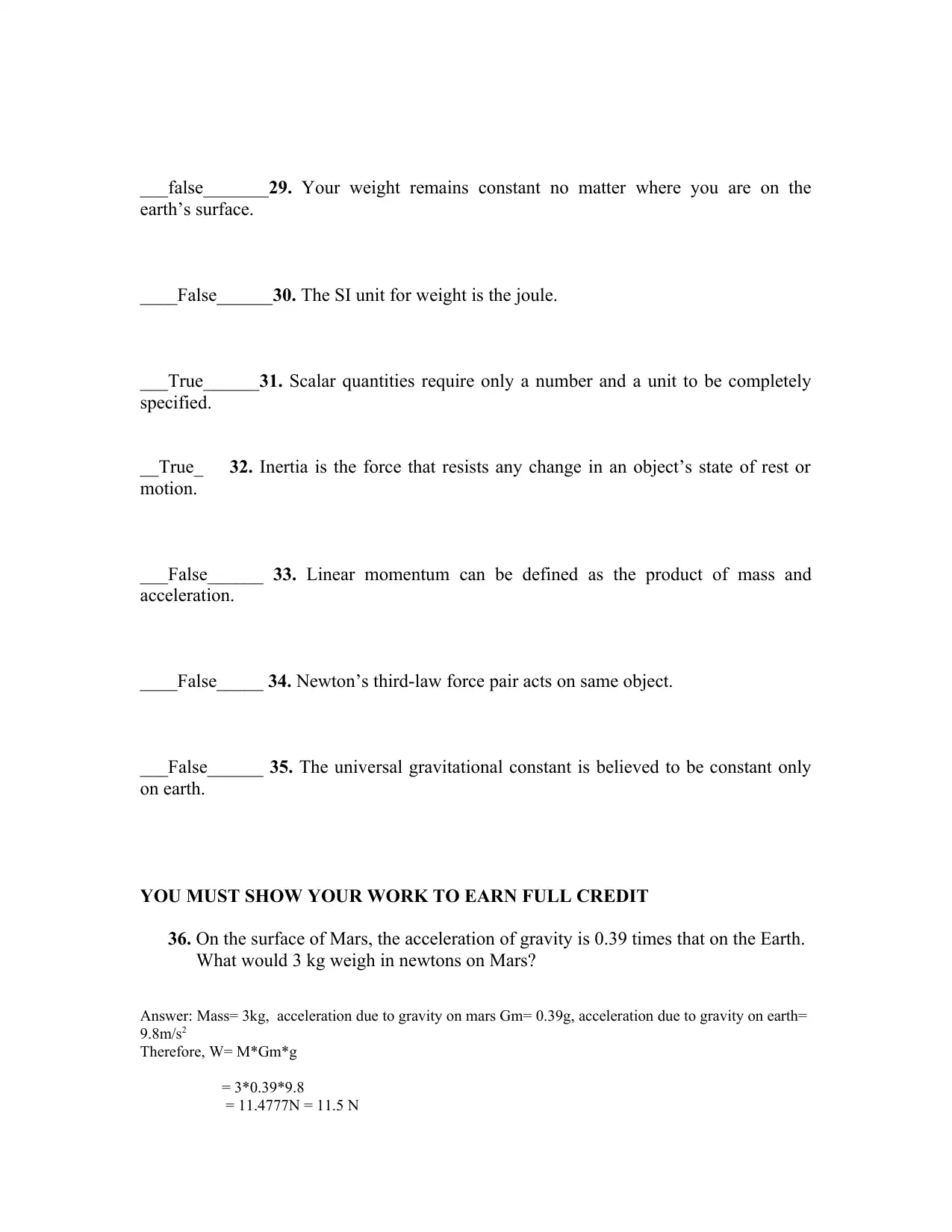
___false_______29. Your weight remains constant no matter where you are on the
earth’s surface.
____False______30. The SI unit for weight is the joule.
___True______31. Scalar quantities require only a number and a unit to be completely
specified.
__True_ 32. Inertia is the force that resists any change in an object’s state of rest or
motion.
___False______ 33. Linear momentum can be defined as the product of mass and
acceleration.
____False_____ 34. Newton’s third-law force pair acts on same object.
___False______ 35. The universal gravitational constant is believed to be constant only
on earth.
YOU MUST SHOW YOUR WORK TO EARN FULL CREDIT
36. On the surface of Mars, the acceleration of gravity is 0.39 times that on the Earth.
What would 3 kg weigh in newtons on Mars?
Answer: Mass= 3kg, acceleration due to gravity on mars Gm= 0.39g, acceleration due to gravity on earth=
9.8m/s2
Therefore, W= M*Gm*g
= 3*0.39*9.8
= 11.4777N = 11.5 N
earth’s surface.
____False______30. The SI unit for weight is the joule.
___True______31. Scalar quantities require only a number and a unit to be completely
specified.
__True_ 32. Inertia is the force that resists any change in an object’s state of rest or
motion.
___False______ 33. Linear momentum can be defined as the product of mass and
acceleration.
____False_____ 34. Newton’s third-law force pair acts on same object.
___False______ 35. The universal gravitational constant is believed to be constant only
on earth.
YOU MUST SHOW YOUR WORK TO EARN FULL CREDIT
36. On the surface of Mars, the acceleration of gravity is 0.39 times that on the Earth.
What would 3 kg weigh in newtons on Mars?
Answer: Mass= 3kg, acceleration due to gravity on mars Gm= 0.39g, acceleration due to gravity on earth=
9.8m/s2
Therefore, W= M*Gm*g
= 3*0.39*9.8
= 11.4777N = 11.5 N

37. A force of 2.1 N is exerted on a 7.0-g rifle bullet. What is the bullet’s
acceleration?
.
Answer: given: mass of the object is 7g and the net force= 2.1 N
We know that, force= mass * acceleration
Therefore, acceleration= force/mass
= 2.1/7 = 0.3 m/s2
38. Describe the relationship between (a) force and acceleration, and (b) mass and
acceleration.
Answer: the relationship between force and acceleration is defined in the Newton’s
Second law of motion. They are directly proportional to each other. If the force is
increased in a body then the acceleration on the body will also increase that Force
equals mass multiplied by acceleration (Mukhopadhyay, 2018).
The relationship between acceleration and mass is that they are inversely
proportional. When the acceleration of a body increases, the mass of the body
decrease and when the mass of a body increases, the acceleration decreases. That is
lighter body will have high acceleration and heavier body will have low acceleration.
39. A 1500-kg car goes from 12 m/s to 36 m/s in 9 s. What is the average force acting
upon it?
Answers: Given, mass of the car is 1500kg, initial velocity= 12m/s, final velocity=
36m/s.
Therefore, Average velocity= 36+12/2 = 48/2= 24m/s
Therefore, Average force= mass*average velocity/time= 1500*24/9= 36000/9= 4000 N
acceleration?
.
Answer: given: mass of the object is 7g and the net force= 2.1 N
We know that, force= mass * acceleration
Therefore, acceleration= force/mass
= 2.1/7 = 0.3 m/s2
38. Describe the relationship between (a) force and acceleration, and (b) mass and
acceleration.
Answer: the relationship between force and acceleration is defined in the Newton’s
Second law of motion. They are directly proportional to each other. If the force is
increased in a body then the acceleration on the body will also increase that Force
equals mass multiplied by acceleration (Mukhopadhyay, 2018).
The relationship between acceleration and mass is that they are inversely
proportional. When the acceleration of a body increases, the mass of the body
decrease and when the mass of a body increases, the acceleration decreases. That is
lighter body will have high acceleration and heavier body will have low acceleration.
39. A 1500-kg car goes from 12 m/s to 36 m/s in 9 s. What is the average force acting
upon it?
Answers: Given, mass of the car is 1500kg, initial velocity= 12m/s, final velocity=
36m/s.
Therefore, Average velocity= 36+12/2 = 48/2= 24m/s
Therefore, Average force= mass*average velocity/time= 1500*24/9= 36000/9= 4000 N
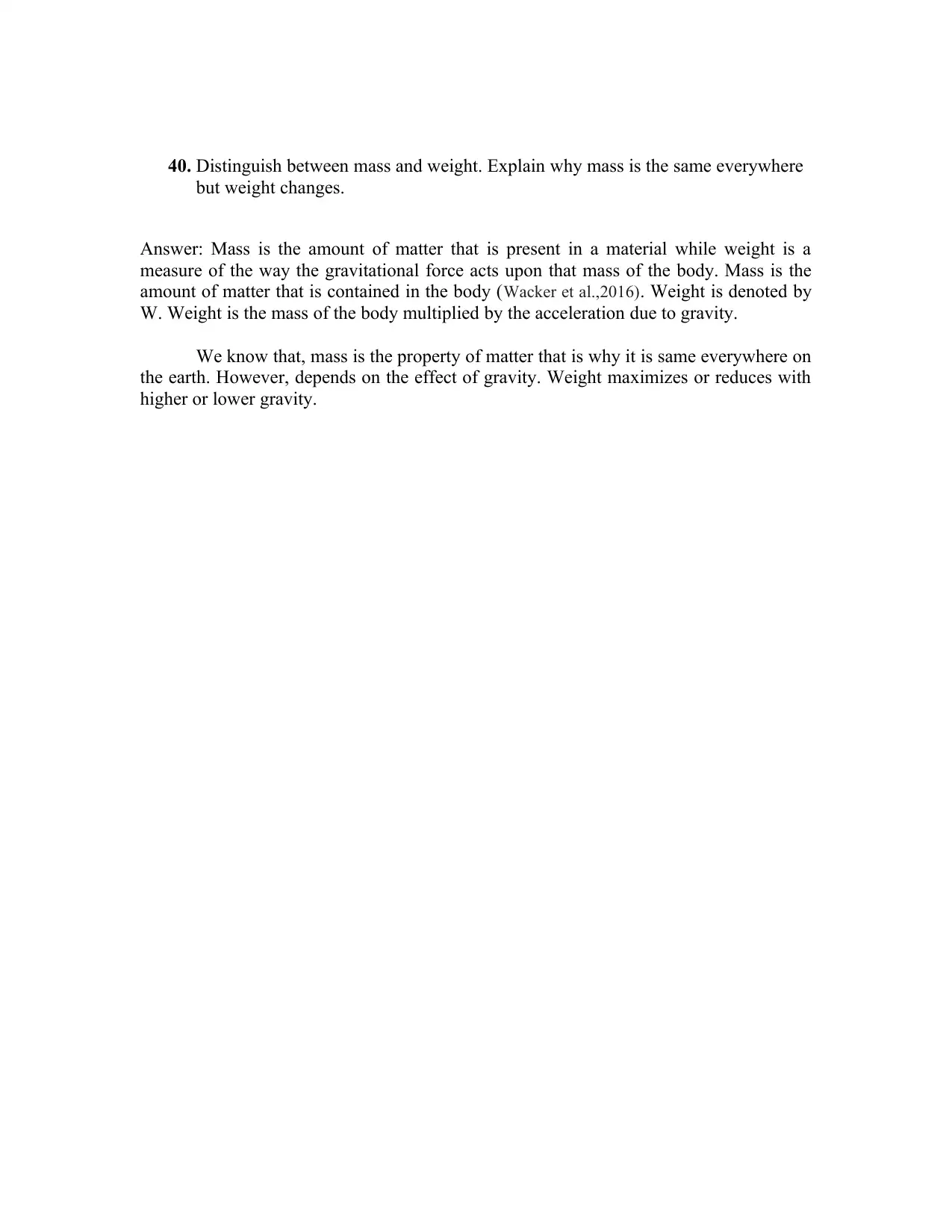
40. Distinguish between mass and weight. Explain why mass is the same everywhere
but weight changes.
Answer: Mass is the amount of matter that is present in a material while weight is a
measure of the way the gravitational force acts upon that mass of the body. Mass is the
amount of matter that is contained in the body (Wacker et al.,2016). Weight is denoted by
W. Weight is the mass of the body multiplied by the acceleration due to gravity.
We know that, mass is the property of matter that is why it is same everywhere on
the earth. However, depends on the effect of gravity. Weight maximizes or reduces with
higher or lower gravity.
but weight changes.
Answer: Mass is the amount of matter that is present in a material while weight is a
measure of the way the gravitational force acts upon that mass of the body. Mass is the
amount of matter that is contained in the body (Wacker et al.,2016). Weight is denoted by
W. Weight is the mass of the body multiplied by the acceleration due to gravity.
We know that, mass is the property of matter that is why it is same everywhere on
the earth. However, depends on the effect of gravity. Weight maximizes or reduces with
higher or lower gravity.
Paraphrase This Document
Need a fresh take? Get an instant paraphrase of this document with our AI Paraphraser

References
Mukhopadhyay, S. (2018). Review on the Newton’s Second Law of Motion in Special Theory of
Relativity. International Journal of Optical Sciences, 4(2), 13-16.
Wacker, L. J., Jørgensen, N. B., Birkmose, D., Winter, N., Mikkelsen, M., Sherson, J., ... & Arlt,
J. J. (2016). Universal three-body physics in ultracold krb mixtures. Physical review
letters, 117(16), 163201.
Mukhopadhyay, S. (2018). Review on the Newton’s Second Law of Motion in Special Theory of
Relativity. International Journal of Optical Sciences, 4(2), 13-16.
Wacker, L. J., Jørgensen, N. B., Birkmose, D., Winter, N., Mikkelsen, M., Sherson, J., ... & Arlt,
J. J. (2016). Universal three-body physics in ultracold krb mixtures. Physical review
letters, 117(16), 163201.
1 out of 8
Related Documents
Your All-in-One AI-Powered Toolkit for Academic Success.
+13062052269
info@desklib.com
Available 24*7 on WhatsApp / Email
![[object Object]](/_next/static/media/star-bottom.7253800d.svg)
Unlock your academic potential
© 2024 | Zucol Services PVT LTD | All rights reserved.





